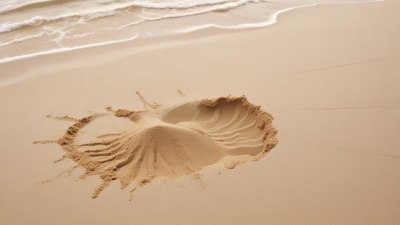What Causes Sea Fog
Explore the scientific principles behind sea fog formation and its impact on maritime activities.

This image was created with the assistance of Freepik
Sea fog is a common phenomenon that occurs when water vapor condenses into tiny droplets, creating a dense cloud of moisture that hangs close to the ocean surface. This atmospheric occurrence can significantly impact visibility and maritime operations, making it a crucial aspect of weather studies. Understanding the causes of sea fog is essential for navigators and anyone involved in ocean activities.
Sea fog typically forms under specific atmospheric conditions, mainly when warm, moist air moves over cooler ocean waters. This temperature difference causes the air to cool rapidly, which can lead to condensation and the formation of fog. The interaction between ocean temperature, air temperature, and humidity plays a vital role in fog formation.
Types of Sea Fog
Sea fog can be categorized into several types based on its formation mechanisms. The main types are advection fog, radiation fog, and evaporation fog. Each type arises from different environmental conditions and can vary in density and duration.
Advection fog occurs when warm, moist air moves horizontally over cooler waters. As the warm air cools down, the water vapor it contains condenses into fog. This type of fog often occurs in coastal regions, especially when warm air from land encounters cooler ocean currents.
Radiation fog, on the other hand, forms when the ocean surface cools at night, leading to cooling of the air just above it. When the air temperature drops to the dew point, condensation occurs, resulting in fog. This type of fog is more common in late summer and early autumn.
Evaporation fog, also known as steam fog, forms when cold air moves over warmer water. The cold air causes moisture to evaporate from the surface, creating fog. This type of fog is often seen over rivers, lakes, or oceans during autumn months and is characterized by its short-lived nature.
Sea Temperature and Fog Formation
The temperature of the sea surface plays a crucial role in fog formation. Warm sea waters can significantly influence the creation of fog, particularly in regions subject to maritime weather conditions. When warm sea air comes into contact with cooler air masses, particularly during evenings or in early mornings, fog can form rapidly.
Additionally, fluctuations in ocean currents can lead to changes in sea temperatures, further impacting fog density and occurrence. Cold currents can create a stark temperature gradient that promotes fog formation whenever warm air moves into the area.
Sea temperature is generally affected by various factors, including seasonal changes, geographic location, and ocean currents, which means that different regions may experience varying instances of sea fog due to these conditions.
Humidity and Its Effect on Fog
The humidity level in the atmosphere is another critical factor determining whether sea fog will form. High humidity means that the air is saturated with moisture, making it easier for fog to develop when conditions change. When warm, moist air meets a cooler environment, the excess moisture in the air condenses into tiny water droplets, creating fog.
Regions with high humidity levels, especially coastal areas, are more prone to fog events. During summer, conditions can lead to rising humidity levels as warm air rushes toward the sea, increasing the likelihood of sea fog.
Wind and Its Influence on Sea Fog
Wind also plays a vital role in sea fog formation. On calm days, fog can develop quickly, as there is little to dissipate the air masses. However, when winds are present, the distribution of temperature and humidity can change, either dispersing the fog or promoting its formation in certain conditions.
For instance, a light onshore breeze might bring warm air onto cooler waters, increasing the chances of advection fog. Conversely, strong winds can mix different air layers, making it challenging for fog to persist. The interplay between wind patterns and temperature gradients ultimately dictates whether fog will develop or dissipate.
Geographical Influence on Sea Fog
The geography of a region significantly affects its fog formation. Coastal regions with large temperature contrasts between water and air, such as California's coast, are notorious for their dense fog. The Pacific Ocean's cold currents combined with warm offshore air are conducive to advection fog, leading to famous foggy conditions.
Similarly, the Gulf Stream influences weather patterns along the eastern United States. Warm, moist air moving northward over the cooler waters of the Atlantic Ocean often results in fog development, especially in the spring and autumn months. In contrast, areas with stable weather patterns or less temperature variation may not experience fog as frequently.
Climate Change and Sea Fog
Climate change significantly impacts weather patterns, including sea fog occurrences. Rising ocean temperatures and changes in atmospheric conditions can potentially alter typical fog formation patterns. Warmer ocean temperatures can result in more evaporation, leading to increased humidity levels that may result in more frequent fog events.
Conversely, climate change can also lead to changes in wind patterns, which might affect the mixing of air layers and, consequently, fog formation. Understanding these patterns is vital for predicting future seas fog occurrence in the context of longer-term climate variability.
Impact of Sea Fog on Navigation
The presence of sea fog can have drastic implications for navigation and maritime activities. Reduced visibility poses challenges for ships and boats, which must navigate safely while maintaining awareness of their surroundings. Many vessels rely on radar and GPS for navigation in foggy conditions, but these tools are not infallible.
Collisions between vessels are a considerable risk during fog, making it essential for all maritime operators to observe safety protocols and maintain communication. In dense fog, ships may also need to reduce speed, which can impact travel times and schedules. Some ports may even close during severe fog, halting all shipping activities until visibility improves.
Fog and Fishing Activities
Fishing activities are also impacted by sea fog. Commercial and recreational fishers must be cognizant of fog conditions while out on the water. Navigating fog can limit accessibility to certain fishing areas and can pose risks to those on smaller vessels who may be less equipped to handle low visibility.
Additionally, fishers rely on specific patterns of weather and environmental conditions, and fog may disrupt their ability to track fish movements effectively. Thus, understanding and adapting to fog conditions is critical for maximizing the success of fishing expeditions.
Sea fog is a complex and fascinating meteorological phenomenon, influenced by various factors such as temperature, humidity, wind, and geographical conditions. It plays a significant role in navigation, fishing activities, and overall maritime operations. As climate change continues to impact global weather patterns, understanding the dynamics of sea fog becomes increasingly vital for ensuring safety and efficiency in sea-related activities. Awareness of sea fog's causes and implications is essential for those who rely on the ocean, from commercial shipping industries to recreational water enthusiasts.











